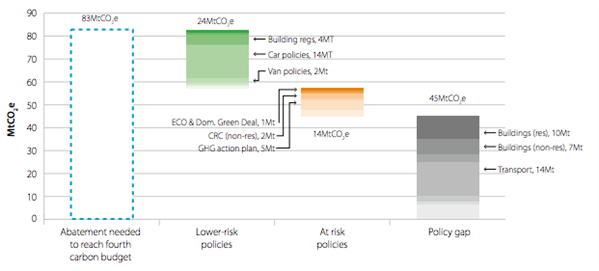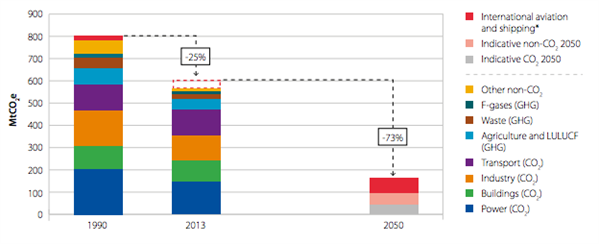The UK will miss its legally-binding carbon budgets in future without new policies, according to the government’s Committee on Climate Change (CCC).
The UK’s first ever carbon budget running from 2008 to 2012 was met, the CCC says in its latest Progress Report, and there has been good progress on car fuel efficiency, installing more efficient boilers and building wind turbines. But that’s about where the good news for government ends.
The first budget was met largely because of the 2008 economic crisis slashing industrial output and ripping a hole in consumers’ pockets, the CCC says. Lower output and lower demand reduced the need to burn fossil fuels in power stations, cars and boilers.
Without the impact of the crash and a particularly cold winter in 2010, emissions would have fallen by around 1 per cent per year between 2007 and 2012. To meet the fourth carbon budget in 2027 that rate will need to triple.
Policy gap
The problem is that there is a large gap between legislated policy and the ambition needed to push annual emissions cuts towards that 3 per cent level. The CCC says this policy gap is bigger than the government thinks because some policies won’t deliver expected savings.
The CCC has called for greater ambition on climate policy plenty of times before. But this report is different because it takes a much more detailed and comprehensive look at government policies and whether they will deliver as expected.
Adrian Gault, acting head of the government’s Committee on Climate Change tells Carbon Brief:
“In previous reports where we’ve identified a need for faster progress, that’s been largely based around an assessment of how fast are we moving now and comparing that to the rate of progress that’s required to meet the budgets. This time around we’re actually going about it in much more detail, assessing the policy measures that the government has and assessing the extent to which we think those will deliver carbon savings.
“For each of these policy measures that government has got within its programme, we’ve tried to assess what savings in emissions we expect that policy programme to deliver and what’s at risk in delivery of that amountâ?¦ Our view is that policies will not deliver as much as government is expecting.”
This leaves a gap in the UK’s climate ambition that will need to be filled if we are to meet future carbon budgets. Gault says “government plans to fill that gap are currently very vague”.
Emissions in 2025 need to be cut by 31 per cent (175 million tonnes) compared to the 564 million tonnes emitted in 2013, the CCC says. But current policies will only take emissions down by a maximum of 23 per cent, it says.
The parts of the economy that are part of the EU emissions trading scheme will be expected to save 92 million tonnes (41 per cent). The non-traded sector – the rest of the economy – will be expected to save 83 million tonnes (24 per cent).
The policy gap for the non-traded sector is particularly large, as the chart below shows. Of that 83 million tonne saving requirement just 24 (green bars) is locked in. A further 14 million tonnes of savings (orange bars) are at risk and may never materialise, the CCC says.

Source: CCC Progress Report 2014
The CCC has rated climate policy progress across the board using a traffic light system. Green means things have gone better than it expected. Amber shows slight under-performance and red a significant shortfall.
The scorecard isn’t too positive with 18 red or amber ratings and five greens.
Green ratings include: uptake of more efficient boilers; car fuel efficiency; and progress on wind energy. The 11 amber ratings include: loft and cavity wall insulation; new nuclear capacity; uptake of more efficient appliances; and biofuels.
Red ratings include: solid wall insulation; low carbon heat in buildings; the Green Deal energy efficiency scheme; electric vehicles (there are less than 10,000 on the road); and carbon capture and storage.
Uptake of home heat pumps, home energy efficiency and electric cars have been highlighted by some of the coverage of the CCC’s report. But what are the biggest risks to meeting future carbon budgets? When Carbon Brief asks, acting CCC boss Gault isn’t keen on saying.
That’s because progress is needed across the board, he says. If you look at the graph below it’s pretty obvious why. Cutting out all emissions from any single sector of the economy would be insufficient to reach the UK’s 2050 target, shown on the right hand side.

Source: CCC Progress Report 2014
It’s always worth being reminded of the massive level of ambition set out by the UK’s pioneering climate change legislation. Even though the CCC has identified a big policy gap on the road to that 2050 target, at least we are going in the right direction.

